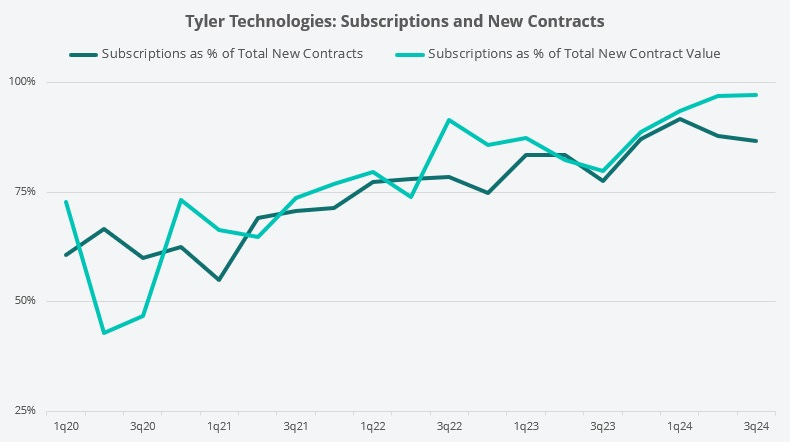Tyler reported results for the third quarter of 2024. Here are what I think are the financial highlights:
Total revenues were $543.3 million, up 9.8%. On an organic basis, revenues grew 9.4%;
SaaS revenues grew 20.3% to $166.6 million. On an organic basis, SaaS revenues grew 19.7%;
Finally, profits and cash flows grew faster than total revenues:
GAAP operating income was $82.8 million (15.2% margin), up 29.5%. Non-GAAP operating income was $137.8 million (25.4% margin), up 12.4%; and
Free cash flow was $252.9 million, up 55.5%.
This is outstanding, especially considering there is still a long way to go before Tyler converts most of its customers to cloud versions of its products. Over the next ten years, operating margins will rise as it shifts 100% of its cloud-based products to Amazon’s AWS and as Tyler becomes a pure subscription-based software business.
Shift to the Cloud in the Public Sector Continues Apace
At the end of 2019, when it announced a partnership with Amazon’s AWS, Tyler signaled a shift to a “cloud first” approach to its business. Before, Tyler was agnostic as to its business model and way it delivered software to clients. It had no preference for selling on-prem licenses or selling software on a subscription basis that Tyler itself hosted in its own data center. Since the beginning of its partnership with AWS, Tyler now is 100% focused on becoming a pure subscription based company renting its software that is hosted in data centers managed by AWS.
Despite being notorious laggards in the adoption of new technology investments, governments and public service entities in the last several years have more and more embraced all the benefits that the cloud brings to mission critical software. We can see the evidence for this by looking at the percent of new contract wins that are subscription- or cloud-based.
As of the last two quarters, subscription-based contracts have been 97%+ of Tyler’s total new contract value. In addition to winning new SaaS contracts, Tyler has worked diligently to convert existing customers from on-premise software to newer cloud-based versions. Tyler has now flipped 100 or more existing customers two quarters in a row.
Tyler’s cloud first approach has contributed to strong and steady growth of its SaaS (“software as a service”) revenues. For the past year, SaaS revenues have solidly exceeded license and maintenance revenues. Traditional maintenance revenues will slowly decline for the foreseeable future.
Significant New Business Wins
In the past few quarters, Tyler has earned the trust and business of many more new customers, most notably through cross selling. This shows that Tyler’s strategy to expand its product suite by acquiring other software businesses focused on other niches within the public sector continues to pay off.
With their NIC acquisition in 2021, Tyler acquired a large payments processor. Tyler recently signed their first Enterprise Payments deal in the state of California. The deal was with an existing customer and covers more than ten county agencies. Another example is a deal with the city of Fort Collins, CO, that included products in three different categories: Municipal Justice, Enterprise Supervision, and Payments. Fort Collins is the 4th largest city in Colorado.
Finally, in the Courts & Justice category, Tyler had an important win with the Kentucky Court of Justice (KCOJ). This deal is incredible for the fact that it’s another statewide deal—Tyler’s 17th statewide courts deal. It’s also impressive because Kentucky was one of several states with homegrown software systems that remain in the country.
InPractise back in July 2024 posted an interview with a Director of Business Development at CourtView Justice Solutions. A clear takeaway is that home-grown software (i.e., developed in-house, not purchased from an outside vendor) still predominates in the court systems across the country, which provides robust opportunity for Tyler:
Homegrown systems, or custom-built systems, are probably still the predominant player. Yes, largest states like New York, New Jersey, and Connecticut have built their own systems. They are maintaining them, though some are beginning to switch. For example, North Carolina recently transitioned from a homegrown system to Tyler, despite some negative publicity. They continue to bring courts online across the state and the system is growing. So, homegrown systems are still dominant, but we’re seeing an increasing number of these systems going out to bid because they can’t maintain them. They lack the staff to keep up with technology, leading to outdated technology stacks that don’t meet the courts’ needs.
Translation into Financial Results
The operational wins and strategic shift has fueled Tyler’s financial results. Acquisitions, both large and small, have also fueled Tyler’s growth.
The past two quarters in particular have seen a large inflection in free cash flows and free cash flow per share (“FCFpS”). Nine years ago, FCFpS was $2.43 and right now it is $11.96, a CAGR of 19.4% over that time.
Also, Tyler’s impressive cash generation has allowed it to pay down $1.2 billion of term debt—used to acquire NIC in April 2021—in less than three years. Tyler is in a good position to make another large acquisition or return capital to shareholders. The company does not have a dividend, but could easily start paying a small one in the coming years.
Valuation
The one thing that is difficult to like about Tyler is its current valuation. The looming question is whether its future prospects are sufficient to provide a decent return to the shareholder of today. This is the common problem that faces nearly all high quality businesses.
Here’s some very basic math with what I think are reasonable assumptions:
Tyler grows its revenues at a 10% CAGR;
EBITA (earnings before interest, taxes, and amortization) margins improve from 21% to 29%;
Annual dilution of 1.4% to shareholders; and
A stock whose multiple of EV/EBITA compresses from the current 61x to 40x.
The projected result is a 7.4% annualized return over the next six years. The return is in line with the historical market average, but for some, this might not be terribly exciting.
However, Tyler is a highly cash generative business. It has highly predictable revenues, a 98% gross client retention rate, and an ability to increase its market share and make sensible acquisitions. It’s entirely possible I might be underestimating the ability of the market to place a continually high premium on the value of the business.
Please Subscribe
If you enjoyed this content, please share and subscribe.
Want to learn a little more about Tyler? See the Q2 2024 update.
Disclaimers
The content of this publication is for entertainment and educational purposes only and should not be considered a recommendation to buy or sell any particular security. The opinions expressed herein are those of Douglas Ott in his personal capacity and are subject to change without notice. Consider the investment objectives, risks, and expenses before investing.
Investment strategies managed by Andvari Associates LLC, Doug’s employer, may have a position in the securities or assets discussed in any of its writings. Doug himself may have a position in the securities or assets discussed in any of his writings. Securities mentioned may not be representative of Andvari’s or Doug’s current or future investments. Andvari or Doug may re-evaluate their holdings in any mentioned securities and may buy, sell or cover certain positions without notice.
Data sources for all charts come from SEC filings, Koyfin, and other publicly available information.










